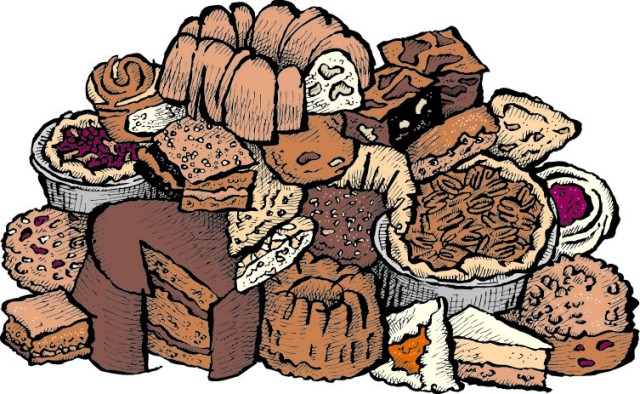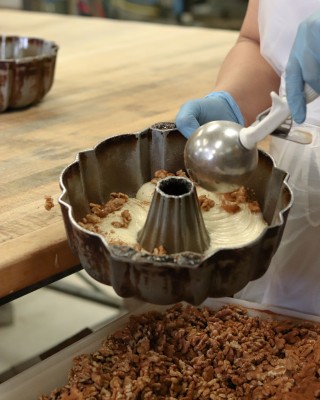
How long will the baked goods last?
All of our Zingerman’s Bakehouse pastries and coffee cakes are baked with full-flavored ingredients, but without preservatives. The good news is we’ve done the hard work of tasting and testing to ensure that they can be enjoyed for weeks to come.
If enjoying soon, keep them at room temperature.
Each baked good will have an “eat or freeze by” sticker that is about two weeks from when the package ships out. If enjoying the treats within a week or so of delivery, they can be kept at room temperature in the packaging they arrived in or in a plastic bag. Avoid the refrigerator, it can ruin the texture.
If enjoying later, keep them in the freezer.
For longer term storage, all of our baked goods freeze well for up to three months. They can be stored in the freezer in their original packaging or, if they’ve been opened, double wrapped in plastic bags.
After the freezer, it is best to allow frozen pastries and coffee cakes to defrost slowly at room temperature in the packaging. That’s all–though with some pastries like scones, a little warm up in an oven will make them extra delicious.

How to store and serve cheese
How should the cheese be stored?
Hard cheeses have been carefully selected to withstand a longer transit time. Don’t worry if it arrives a bit warm or a bit cold – cheese is durable. Hard, aged cheeses stay good for a long time. Many days for sure. Sometimes weeks. Bigger hunks of cheese last longer. If it looks and smelled as expected, it’s likely still great.
Soft cheeses and cheese spreads (like pimento and liptauer) are best eaten within a week or two of receiving them.
We wrap hand-cut wedges of cheese in a cheese bag before shipment, and you can continue to keep the cheese in that cheese bag. The next best option would be parchment or wax paper. After you open the cheese for a nibble, any remainders can be put back into the bag and closed with a simple roll or fold.
Store cheese in the fridge, ideally in the spot closest to 50 degrees. That will likely be the door of your refrigerator or in a drawer where the temperature is consistent but not too cold. Do not freeze your cheese! Cheese is a living thing. Freezing will stop the natural processes that keep cheese so tasty.
What if it’s got a little mold on it? A little mold is no problem. It’s a good sign, it means the cheese is alive. Scrape it off with a knife. But if there’s a lot of mold and it’s turning dark and funky it’s time to say goodbye.
What’s the best way to serve cheese?
Regardless of the kind of cheese, it’s best to take it out of the fridge about 20 to 30 minutes before serving it. Cheese tastes better at room temperature. It makes a world of difference: the aromas expand, becoming more complex; more of the fat spreads on your tongue, which makes the flavor more intense. When cheese is warm you’ll eat less of it and enjoy it more.

Why is our Sour Cream Coffee Cake so great?
The classic American walnut sour cream coffee cake has been our top selling mail order baked good for three decades, almost since the day we turned on the phones at Zingerman’s Mail Order (long before the internet). What makes this cake so great?
The recipe
Zingerman’s coffee cake is made without icing. This makes it looks like an oddball compared to most coffee cakes out there. Nothing against icing, but too many times icing is a ruse. It’s an atmospheric distraction. It diverts your attention from the sub par ingredients that make up the land mass below. Plus, for many folks, me included, it’s too sweet.
Our coffee cake has just a hint of sweetness. It’s richly flavored with creamy sour cream, spiced Korintje cinnamon from Indonesia, and toasted walnuts. After you eat a slice it lingers in your memory.
The packaging
We pack the coffee cake in one of our illustrated cartoon boxes or in one of our wooden crates made by Wisconsin’s last cheese crate manufacturer. The packaging is fantastic for two reasons: it keeps the coffee cake from getting too jostled or smashed on the journey, and it makes for great gift presentation. Bonus points to those clever folks who re-purpose the boxes and crates for pet beds and other fun uses.
The pan
You can’t make the coffee cake without a bundt-style pan. It’s the pan with the hole in the middle which conducts heat to the interior of the cake. The batter for a sour cream coffee cake is very dense. If the hole wasn’t there the middle would stay raw and collapse into a soggy puddle.
The pan was not a part of American baking until the second half of the twentieth century. H. David Dahlquist, founder of Nordic Ware in Minnesota, created it on the request of Rose Joshua and Fannie Schanfield, two members of Minneapolis’s Hadassah Jewish women’s group. They were nostalgic for dense European cakes like kugelhopf and bundkuchen. They showed Dahlquist a European pan with a hole in the middle and he recreated it to sell with his other baking equipment.
Within a decade it was the top selling pan in America. Three decades later, it was our top selling cake.